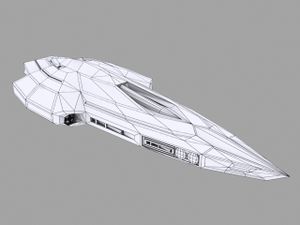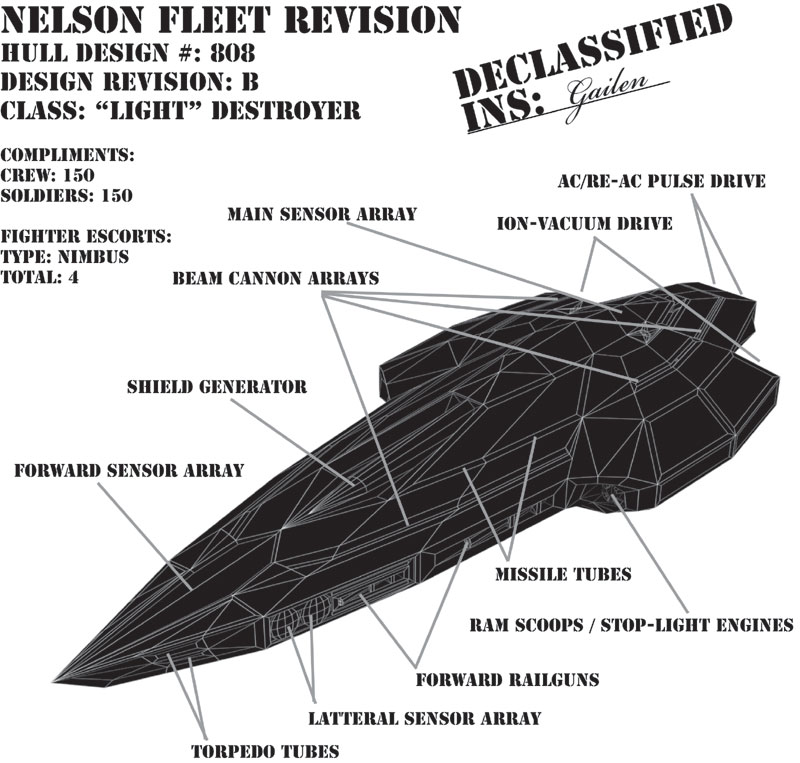Saratoga
N-808-B-305 Gudersnipe School Ship Saratoga, Glorious Heritage-Class Light Destroyer.
The Saratoga was the last ship off the line of the Glorious Heratige-Class production run. Though 350 were initially ordered, the run was stopped at 305, making the N-808-B-305 the very last. Scheduled for destruction or use in munitions tests, the 305 hull was taken to Utopia Gregaria and eventually lost.
Some years later, the incomplete hull was found and assigned to Hunter Jusenkyou.
The Saratoga should not be confused with the Saratoga-B-class of light destroyers produced by the Gailen Fleet Revision.
Notable Elements
The Saratoga was the very last N-808-B ever built, with production stopped while the ship was half-complete and not properly equipped for combat (only the frame, and several non-combat blue systems were complete). Various attempts were made over the years to finish her, but when the ship was finally assigned to Hunter Jusenkyou, she was still only about 70% complete and missing several key-components.
Decades had passed and the correct parts were no longer available, so the newly-assigned crew scavenged components from all over the shipyard to complete her. Since most of the components were taken from much larger ships, this lead to the Saratoga being very heavily over-built.
Among the changes made, the only shield generator the crew could find was designed for a ship three times the Saratoga's size. The crew fitted the generator and re-calibrated it for the Saratoga. The shield, while less power-efficient, proved far more effective in combat.
Engines
The Saratoga uses Ion-Vacuum technology. The engines are speicifed to last for roughly half the ship's intended operational lifespan, which equates to 175,200 flight hours, or around twenty flight-years. This is less than the standard for Support-classed ships, which typically have an engine lifespan of at least thirty flight-years. However, the Saratoga, classes as a "light" destroyer, was meant to have a much less strenuous service carrier.
At one point, it is revealed that Cindy, having never read the ship's operations manuals (or, really, any manuals, for anything, ever, in her life), had configured the helm controls to run the engines at well past their design limits, including using War Emergency Power as the ship's standard cruising speed. As Cloud explains it: in the few short years they've had the ship, they've placed roughly 17,000,000 hours of wear on the ship (one second at W.E.P. is equivalent to ten hours of normal use). This equates to around 2,000 flight-years, or a 5,000-year service life. While extremely long service-lives are not unheard of, with proper maintenance it is not uncommon for ships to reach up to five times their intended operational lifespan. However, for the Saratoga, this would still mean 600 years and 12 engines replacements. To reach the amount of flight-years predicted by Cloud, the ship should have burned through at least 100 sets of engines.
The descrepency is later explained by the over-all robustness of the Ion-vacuum design, combined with modifications made by the crew. Ion-vacuum engines use electromagnets and have few moving parts, which were replaced very frequently as the ship suffered damage. The electromagnets themselves are relatively small, easy to replace, and include several layers of redundancy, while the bulk of the actual stress falls to the superconductors supplying them with power. These were mostly salvaged from much larger ships, and the entire power-system was excessively over-built. The actual output and duty-cycles for the engines, as specified by the manufacturer, were based on the Saratoga's original design, which speced a much smaller power plant and a generally less capable power supply system.
In fact, engines of almost identical design are commonly used in ships over ten times the size of the Saratoga, with comparable performance. All of the crew's modifications effectively gave the ship an engine system on par with that of a dreadnought.
Name
In the short story Against the Wind from The Road to War when Hunter is first told he will recieve a "Glorious Heritage-class" light destroyer, he comments that "I think I'll call her the Saratoga". Astute readers may notice that this is the name of Ryo's father's flagship in the Antelope Books.

